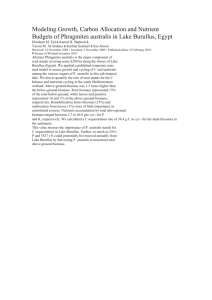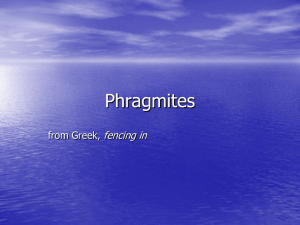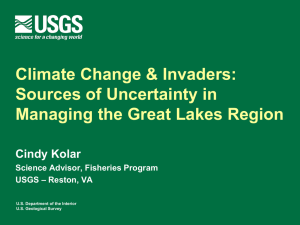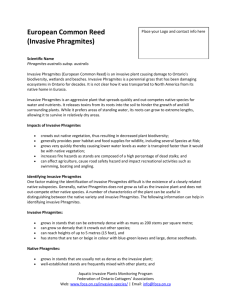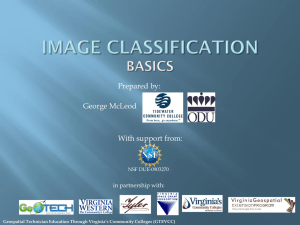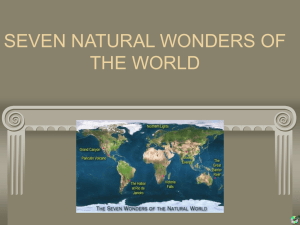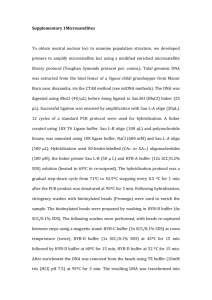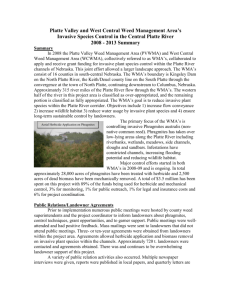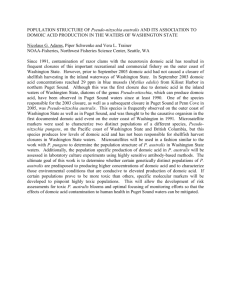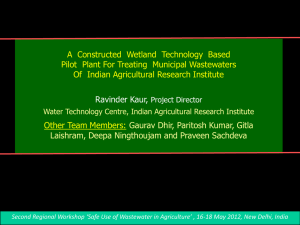gcb12295-sup-0001-ApendixS1
advertisement
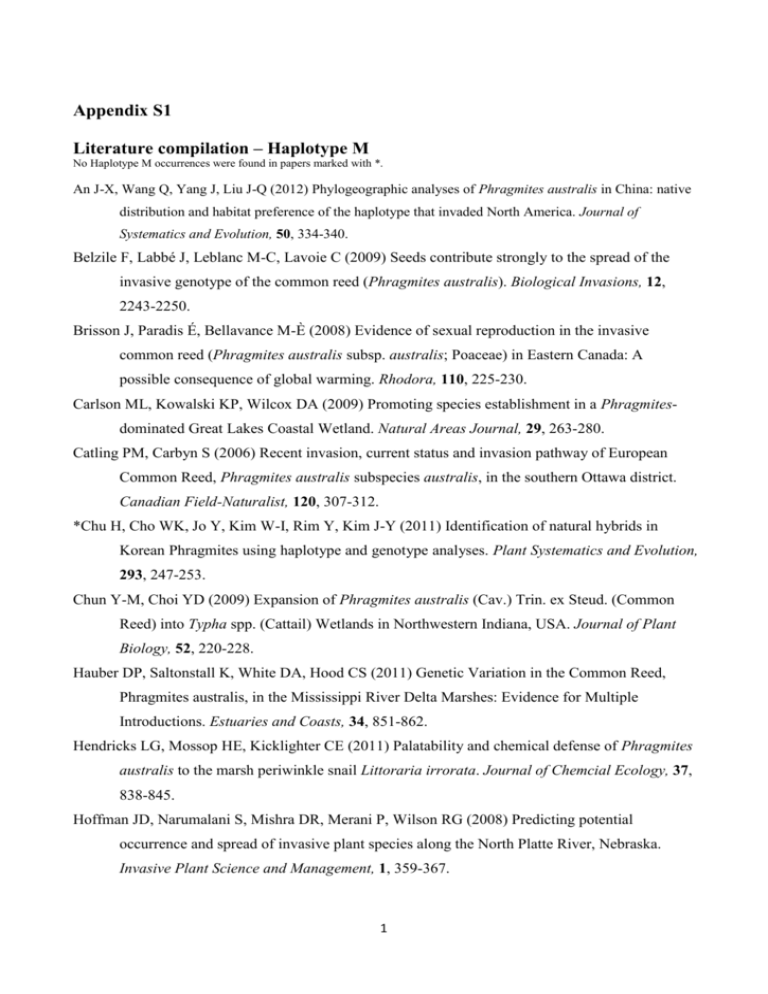
Appendix S1 Literature compilation – Haplotype M No Haplotype M occurrences were found in papers marked with *. An J-X, Wang Q, Yang J, Liu J-Q (2012) Phylogeographic analyses of Phragmites australis in China: native distribution and habitat preference of the haplotype that invaded North America. Journal of Systematics and Evolution, 50, 334-340. Belzile F, Labbé J, Leblanc M-C, Lavoie C (2009) Seeds contribute strongly to the spread of the invasive genotype of the common reed (Phragmites australis). Biological Invasions, 12, 2243-2250. Brisson J, Paradis É, Bellavance M-È (2008) Evidence of sexual reproduction in the invasive common reed (Phragmites australis subsp. australis; Poaceae) in Eastern Canada: A possible consequence of global warming. Rhodora, 110, 225-230. Carlson ML, Kowalski KP, Wilcox DA (2009) Promoting species establishment in a Phragmitesdominated Great Lakes Coastal Wetland. Natural Areas Journal, 29, 263-280. Catling PM, Carbyn S (2006) Recent invasion, current status and invasion pathway of European Common Reed, Phragmites australis subspecies australis, in the southern Ottawa district. Canadian Field-Naturalist, 120, 307-312. *Chu H, Cho WK, Jo Y, Kim W-I, Rim Y, Kim J-Y (2011) Identification of natural hybrids in Korean Phragmites using haplotype and genotype analyses. Plant Systematics and Evolution, 293, 247-253. Chun Y-M, Choi YD (2009) Expansion of Phragmites australis (Cav.) Trin. ex Steud. (Common Reed) into Typha spp. (Cattail) Wetlands in Northwestern Indiana, USA. Journal of Plant Biology, 52, 220-228. Hauber DP, Saltonstall K, White DA, Hood CS (2011) Genetic Variation in the Common Reed, Phragmites australis, in the Mississippi River Delta Marshes: Evidence for Multiple Introductions. Estuaries and Coasts, 34, 851-862. Hendricks LG, Mossop HE, Kicklighter CE (2011) Palatability and chemical defense of Phragmites australis to the marsh periwinkle snail Littoraria irrorata. Journal of Chemcial Ecology, 37, 838-845. Hoffman JD, Narumalani S, Mishra DR, Merani P, Wilson RG (2008) Predicting potential occurrence and spread of invasive plant species along the North Platte River, Nebraska. Invasive Plant Science and Management, 1, 359-367. 1 Holdredge C, Bertness MD, Von Wettberg E, Silliman BR (2010) Nutrient enrichment enhances hidden differences in phenotype to drive a cryptic plant invasion. Oikos, 119, 1776-1784. Howard RJ, Travis SE, Sikes BA (2007) Rapid growth of a Eurasian haplotype of Phragmites australis in a restored brackish marsh in Louisiana, USA. Biological Invasions, 10, 369-379. Jodoin Y, Lavoie C, Villeneuve P, Theriault M, Beaulieu J, Belzile F (2008) Highways as corridors and habitats for the invasive common reed Phragmites australis in Quebec, Canada. Journal of Applied Ecology, 45, 459-466. Kettenring KM, Mccormick MK, Baron HM, Whigham DF (2009) Phragmites australis (Common Reed) invasion in the Rhode River Subestuary of the Chesapeake Bay: disentangling theeffects of foliar nutrients, genetic diversity, patch size, and seed viability. Estuaries and Coasts, 33, 118-126. Kettenring KM, Whigham DF (2009) Seed viability and seed dormancy of non-native Phragmites australis in suburbanized and forested watersheds of the Chesapeake Bay, USA. Aquatic Botany, 91, 199-204. Konisky RA, Burdick DM (2004) Effects of stressors on invasive and halophytic plants of New England salt marshes: A framework for predicting response to tidal restoration. Wetlands, 24, 434-447. Kulmatiski A, Beard KH, Meyerson LA, Gibson JR, Mock KE (2011) Nonnative Phragmites australis invasion into Utah Wetlands. Western North American Naturalist, 70, 541-552. Lambert AM, Casagrande RA (2006a) Distribution of native and exotic Phragmites australis in Rhode island. Northeastern Naturalist, 13, 551-560. Lambert AM, Casagrande RA (2006b) No evidence of fungal endophytes in native and exotic Phragmites australis. Northeastern Naturalist, 13, 561-568. Lambert AM, Casagrande RA (2007a) Characteristics of a successful estuarine invader: evidence of self-compatibility in native and non-native lineages of Phragmites australis. Marine Ecology-Progress Series, 337, 299-301. Lambert AM, Casagrande RA (2007b) Susceptibility of native and non-native common reed to the non-native Mealy Plum Aphid (Homoptera: Aphididae) in North America. Environmental Entomology, 36, 451-457. Lambert AM, Winiarski K, Casagrande RA (2007) Distribution and impact of exotic gall flies (Lipara sp.) on native and exotic Phragmites australis. Aquatic Botany, 86, 163-170. 2 League MT, Colbert EP, Seliskar DM, Gallagher JL (2006) Rhizome growth dynamics of native and exotic haplotypes of Phragmites australis (common reed). Estuaries and Coasts, 29, 269-276. Leblanc MC, De Blois S, Lavoie C (2010) The invasion of a large lake by the Eurasian genotype of common reed: The influence of roads and residential construction. Journal of Great Lakes Research, 36, 554-560. Lelong B, Lavoie C, Jodoin Y, Belzile F (2007) Expansion pathways of the exotic common reed (Phragmites australis): a historical and genetic analysis. Diversity and Distributions, 13, 430-437. Lynch EA, Saltonstall K (2002) Paleoecological and genetic analyses provide evidence for recent colonization of native Phragmites australis populations in a lake superior wetland. Wetlands, 22, 637-646. Maheu-Giroux M (2005) The landscape ecology of the invasive species Phragmites australis in anthropogenic linear wetlands. Unpublished Master of Science McGill University, SaintAnne-de-Bellevue, Québec, Canada 88 pp. McCormick MK, Kettenring KM, Baron HM, Whigham DF (2009) Extent and reproductive mechanisms of Phragmites australis spread in Brackish Wetlands in Chesapeake Bay, Maryland (USA). Wetlands, 30, 67-74. McCormick MK, Kettenring KM, Baron HM, Whigham DF (2010) Spread of invasive Phragmites australis in estuaries with differing degrees of development: genetic patterns, allee effects and interpretation. Journal of Ecology, 98, 1369-1378. Meadows RE, Saltonstall K (2007) Distribution of native and introduced Phragmites australis in freshwater and oligohaline tidal marshes of the Delmarva Peninsula and southern New Jersey. Journal of the Torrey Botanical Society, 134, 99-107. Meyerson LA, Viola DV, Brown RN (2009) Hybridization of invasive Phragmites australis with a native subspecies in North America. Biological Invasions, 12, 103-111. Minchinton TE, Bertness MD (2003) Disturbance-mediated competition and the spread of Phragmites australis in a coastal marsh. Ecological Applications, 13, 1400-1416. Mozdzer TJ, Hutto CJ, Clarke PA, Field DP (2008) Efficacy of Imazapyr and Glyphosate in the control of non-native Phragmites australis. Restoration Ecology, 16, 221-224. 3 Mozdzer TJ, Zieman JC (2010) Ecophysiological differences between genetic lineages facilitate the invasion of non-native Phragmites australis in North American Atlantic coast wetlands. Journal of Ecology, 98, 451-458. Mozdzer TJ, Zieman JC, Mcglathery KJ (2010) Nitrogen uptake by native and invasive temperate coastal macrophytes: Importance of dissolved organic nitrogen. Estuaries and Coasts, 33, 784-797. Overholt WA, Diaz R, Hanson M, Williams D (2011) Phragmites in Florida. pp Page, Gainesville, FL, Department of Entomology and Nematology, Florida Cooperative Extension Service, Institute of Food and Agricultural Sciences, University of Florida. Packett CR, Chambers RM (2006) Distribution and nutrient status of Haplotypes of the marsh grass Phragmites australis along the Rappahannock River in Virginia. Estuaries and Coasts, 29, 1222-1225. Park MG, Blossey B (2008) Importance of plant traits and herbivory for invasiveness of Phragmites australis (Poaceae). America Journal of Botany, 95, 1557-1568. Paul J, Vachon N, Garroway CJ, Freeland JR (2010) Molecular data provide strong evidence of natural hybridization between native and introduced lineages of Phragmites australis in North America. Biological Invasions, 12, 2967-2973. Payne RE, Blossey B (2007) Presence and abundance of native and introduced Phragmites australis (Poaceae) in Falmouth, Massachusetts. Rhodora, 109, 96-100. Rickey MA, Anderson RC (2004) Effects of nitrogen addition on the invasive grass Phragmites australis and a native competitor Spartina pectinata. Journal of Applied Ecology, 41, 888896. Rothman E, Bouchard V (2007) Regulation of carbon processes by macrophyte species in a Great Lakes coastal wetland. Wetlands, 27, 1134-1143. Saltonstall K, Court Stevenson J (2007) The effect of nutrients on seedling growth of native and introduced Phragmites australis. Aquatic Botany, 86, 331-336. Saltonstall K, Glennon K, Burnett A, Hunter RB, Hunter KL (2007) Comparison of morphological variation indicative of ploidy level in Phragmites australis (Poaceae) from eastern North America. Rhodora, 109, 415-429. Shanahan SA, Nelson SM, Van Dooremolen DM, Eckberg JR (2011) Restoring habitat for riparian birds in the lower Colorado River watershed: An example from the Las Vegas Wash, Nevada. Journal of Arid Environments, 75, 1182-1190. 4 Siersma H (2007) Mapping the native and invasive haplotypes of Phragmites australis in the nature preserves of the Little Traverse Conservancy Unpublished M.S.E.S Cornell University Ithaca, NY 32 pp. Tulbure MG, Johnston CA, Auger DL (2007) Rapid invasion of a Great Lakes coastal wetland by non-native Phragmites australis and Typha. Journal of Great Lakes Research, 33, 269-279. Vasquez EA, Glenn EP, Brown JJ, Guntenspergen GR, Nelson SG (2005) Salt tolerance underlies the cryptic invasion of North American salt marshes by an introduced haplotype of the common reed Phragmites australis (Poaceae). Marine Ecology Progress Series, 298, 1-8. Vasquez EA, Glenn EP, Guntenspergen GR, Brown JJ, Nelson SG (2006) Salt tolerance and osmotic adjustment of Spartina alterniflora (Poaceae) and the invasive M haplotype of Phragmite australis (Poaceae) along a salinity gradient. American Journal of Botany, 93, 1784-1790. Walters S (2010) Carbon dynamics in a Phragmites australis invaded riparian wetlant. Unpublished Master of Science University of Nebraska Lincoln, Nebraska 53 pp. Walton DJ (2010) Survey of Phragmites australis in water sources in Michigan's Northern Lower Peninsula. Unpublished Bachelor of Arts Kalamazoon College, Kalamazoo, MI 38 pp. Weinstein MP, Litvin SY, Guida VG (2009) Essential fish habitat and wetland restoration success: A tier III approach to the biochemical condition of common mummichog fundulus heteroclitus in common reed Phragmites australis- and smooth cordgrass Spartina alterniflora-dominated salt marshes. Estuaries and Coasts, 32, 1011-1022. Wilcox KL, Petrie SA, Maynard LA, Meyer SW (2003) Historical distribution and abundance of Phragmites australis at Long Point, Lake Erie, Ontario. Journal of Great Lakes Research, 29, 664-680. 5
